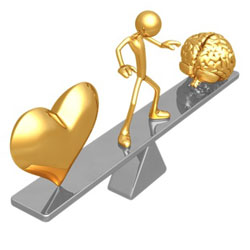Most businesses, organizations and institutions today recognize that necessity and benefit of harnessing their human capital. Due to the fact that the world has changed so much and because we are in a constant state of change, managers have to find ways to maximise the production of their human capital and people (employees) have to find new competencies so that they can maximise their own productivity.
According to Wikipedia (the guru of all knowledge in the new world of work) the definition of human capital is:
the stock of competencies, knowledge, social and personality attributes, including creativity, embodied in the ability to perform labor so as to produce economic value.
What I love about this definition is that it includes the word creativity. Dan Pink (the author of the wonderful book Drive about what truly motivates people) has recently published a book called A Whole New Mind: Why Right-Brainers Will Rule The Future, which emphasizes the importance of creative thinking. Even an international law firm has recently redefined their core values; and have included creativity in their new list, which really goes to show how important this human attribute is in the most cerebral and competitive of environments.
What is interesting is that humans have an innate sense of creativity. But I agree with Sir Ken Robinson that largely education systems around the world knock that creativity out of us; and so by the time we reach the workplace, we have to relearn it. The question is, why would we need to relearn it? The answer is simple and complex and is found in a lot of what we do at TomorrowToday.
To borrow from what Robinson has said in the past, the school system historically has ‘manufactured’ people. This way of producing human capital in a manufacturing economy appeared to be sufficient, but we have moved on from this kind of economy and are moving rapidly into much more complex working environments. The new world of work requires humans to be a lot more than just manufactured to follow simple instructions and comply with repetitive tasks. One simple example of what I am talking about would be the impact that the advancement of technology has had on ‘computer intelligence’ replacing human intelligence where applicable. The example I use, because it is one most people can relate to, is our mobile phones. How many of us have stored in our own private memory banks more than say five phone numbers, maximum? We no longer need to store this information inside our heads, because we have devices that we can carry around in our pockets and handbags that store the information for us. Furthermore this device that started out being able to connect us with others telephonically, gets used for a whole lot of other things today. Like telling the time, waking us up in the morning, sending instant messages, checking emails, watching videos and playing games. What we learn from this example is a) what we need to store in our heads has changed because we have different devices and b) what we do with the information that we do store in our heads has changed because we have different devices. This notion will manifest itself differently in different industries and environments. What we all share, however, is that we are all being impacted regardless of what industry we are in; and so have to prepare ourselves for what is already and what is to come.
One of the greatest things you can do for your children if you are a parent, for your employees if you are a manager, for your students if you are in education; and most importantly for yourself as a person, is to inspire creativity. Creativity in this context is not about writing beautiful poetry or being able to capture life through art, it is about being able to think laterally, convergently and in solution-orientated ways, which are skills needed to navigate one’s way through life today. The quote above defining human capital spoke of creativity being one personality attribute, which leads me to believe that inspiring creativity is intractably linked to one’s understanding of one’s self and what drives our unconscious thoughts, feelings and behaviours. It is also about understanding that we have so much more than just head intelligence, but that we can benefit from our heart and intuitive intelligence if we know how to exercise all three. This would allow us to exercise our true creativity.
The Enneagram is the most profound system that I know of to understand oneself as well as to understand where your center of intelligence lies. It can also act as a map that can accurately illuminate what motivates your way of thinking, feeling and being in the world. These unconscious patterns that we set up to cope with the world are then manifested as learning and communication styles, behavioral patterns, the way we manage conflict, time and ourselves. They explain the buttons that get pushed that impact relationships, what’s important to us in terms of our value system and how we hear things (which may or may not be an accurate assessment of what was said). They unpack why we have certain impulses that would govern how we manage, how we learn, how we engage with others, what would make sense to us and what would seem odd to us in others. Likewise the Enneagram would highlight how we could all contribute to creativity, not because it is something we should do but because creativity is something that we all can do in different ways.
If you know the Enneagram, think about how you can utilize the Enneagram to enhance your own creativity in order to enhance your own economic value within the organization in which you work. If you do not know the Enneagram and would like to know more about it so that you can grow your own creativity, please email me on: [email protected]


